The Hibbing that Shaped the Life of Bob Dylan
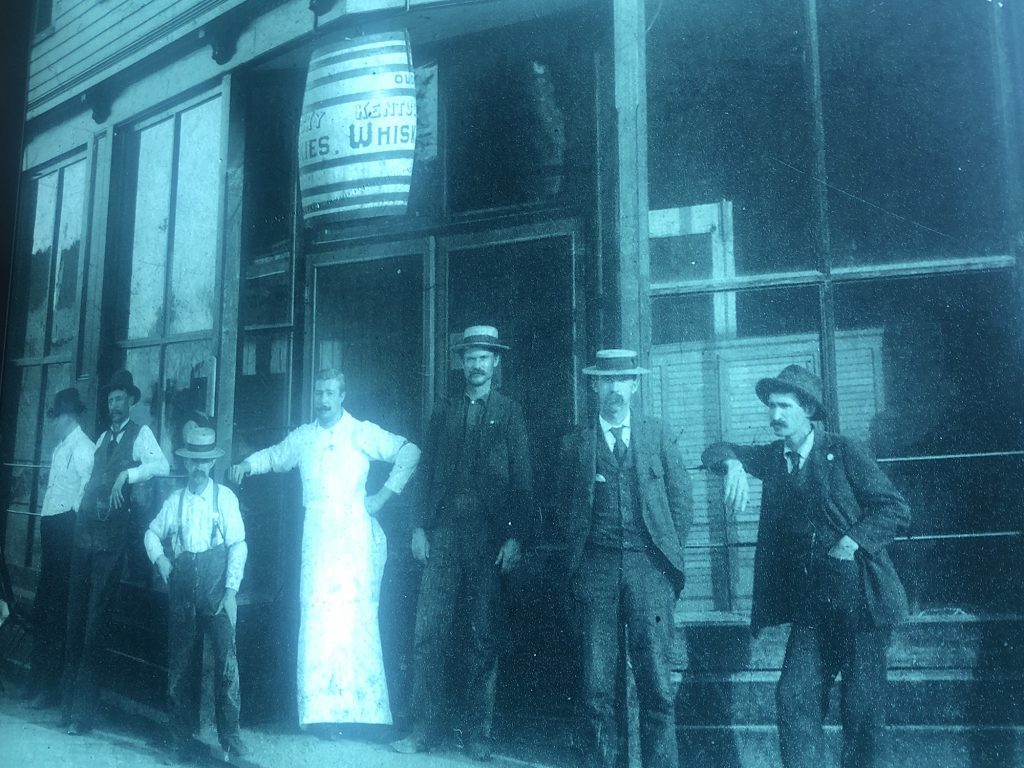
Early “North Country Blues” in Hibbing.
HIBBING, MN.–I drove alone into the north country unguarded. I carried no expectation or pretense. A songbird hovered along a roadside lake. A good highway leads to connections.
Hibbing did not disappoint.
I thought Hibbing would be a nice companion piece to last summer’s trip to the Bob Dylan Center in Tulsa, Ok. Robert Zimmerman was born May 24, 1941, in Duluth, 75 miles to the east of Hibbing. But he spent his formative years in Hibbing. When Dylan was seven years old his father Abram moved the Zimmerman family to Hibbing where he opened a hardware store. Between 1948 and 1959 the family lived at 2425 7th Avenue E. near downtown Hibbing.
For Dylanologists, Hibbing (pop. 16,000) is many things Tulsa is not. There is no monetization of the Dylan mystique, no Dylan statues, no tee-shirts, no membership fees and the “Welcome to the City of Hibbing” road signs have no mention of Dylan. Visitors are pretty much on their own. Like a rolling stone.
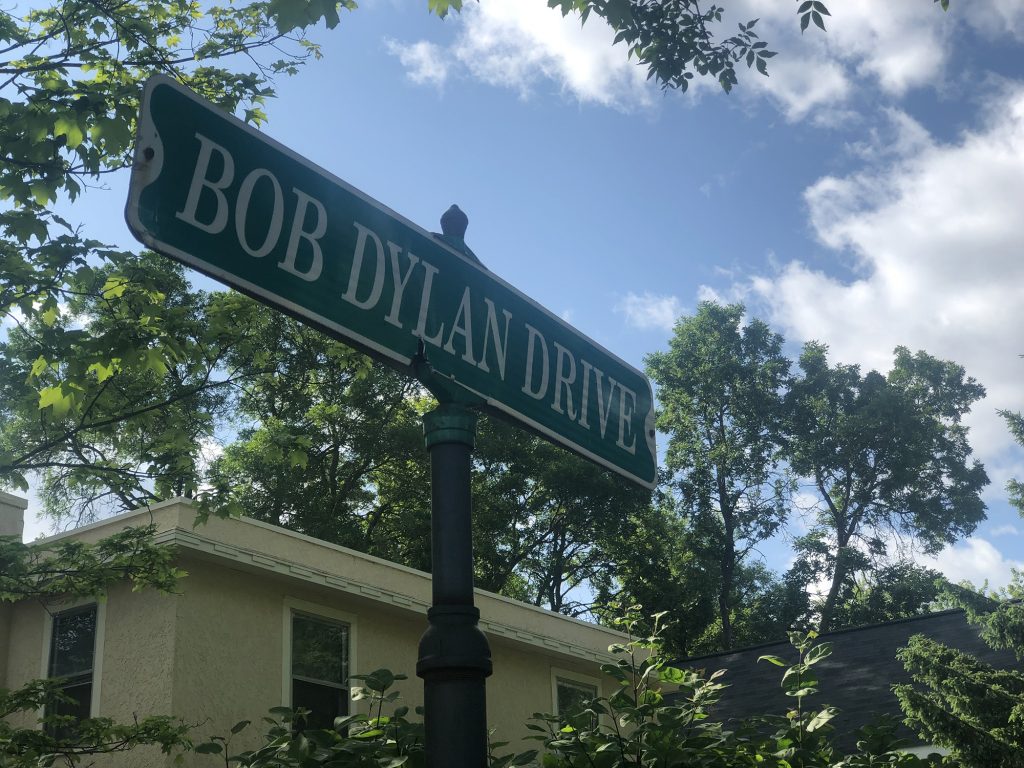
This nod to Bob was added in 2005 on the street in front of his house (pictured.)
The key to my visit was a Bob Dylan Walk created by the Hibbing Public Library. The walk consists of 14 pivotal places in Dylan’s childhood. It makes the experience become a living, breathing museum. The sites are mostly in or near the downtown East Howard Commercial Historic District, which is on the National Register of Historic Places. The area was designed and built for Hibbing by the Oliver Iron Mining Company from 1920 to 1921. In just a few minutes on the walk, you feel like you’ve tumbled into the set of a silent movie. I was so jacked to see these places, I knocked off a few sites the minute I arrived in town on a Sunday afternoon.
I first stopped for provisions at Super One Foods near the forever white pine trees on the outskirts of town. I told the collegiate checkout guy why I was in Hibbing. And he told me that his cousin was related to the late Echo Helfstrom, Dylan’s high school sweetheart who was figured to be the inspiration for his ballad “Girl From the North Country.”
Even in a grocery store, I saw Hibbing’s connection with history. The walls of the store were lined with large black and white photographs depicting Hibbing’s past such as the world’s largest iron ore mine and the birthplace of the Greyhound bus company. Most of the photos were made by Paul Aubin, Sr. who came to North Hibbing in 1903 and opened his studio in 1907.
But there were no photos of Bob Dylan.
From the grocery store, it was about a five-minute drive to Dylan’s boyhood home. According to the library, the two-story wood-framed stucco house is an example of the Mediterranean Modern style that was found throughout Hibbing in the mid-1940s. The house was built in 1939.
Dylan mega fan and collector Bill Pagel operates the intense BobLinks site. One of his earliest Dylan acquisitions was a high chair once used by the singer-songwriter. In 2019 Pagel bought the Dylan Hibbing home. The house had been valued at $84,000, according to Zillow. Of course, Pagel, a pharmacist by trade, also owns the Dylan house at 519 N. 3rd Ave East in the Central Hillside neighborhood of Duluth. And to think, I only collect bobbleheads.
Neither the Duluth house nor the Hibbing house is open to the public. However, since Pagel spends most of his time in Hibbing he does give tours by appointment. He can be found on Facebook. Pagel has also shared artifacts with the Dylan Center in Tulsa.
In an e-mail last week Pagel told me that some of Dylan’s relatives have visited the homes. “A few weeks ago Henry Paul, the founding member of Blackhawk is a big Dylan fan and he toured the Hibbing house,” Pagel wrote. “In the past Scarlet Rivera (Chicago native and Dylan’s Rolling Thunder Revue violinist) and Eric Anderson have visited the Duluth house.”
I wandered around the house which is located on a quiet corner lot. No one was walking around the neighborhood. After ten minutes an old hippie named Roy was rolling down 7th Avenue on a vintage bicycle. I flagged him down to take my picture in front of the house. He was accommodating.
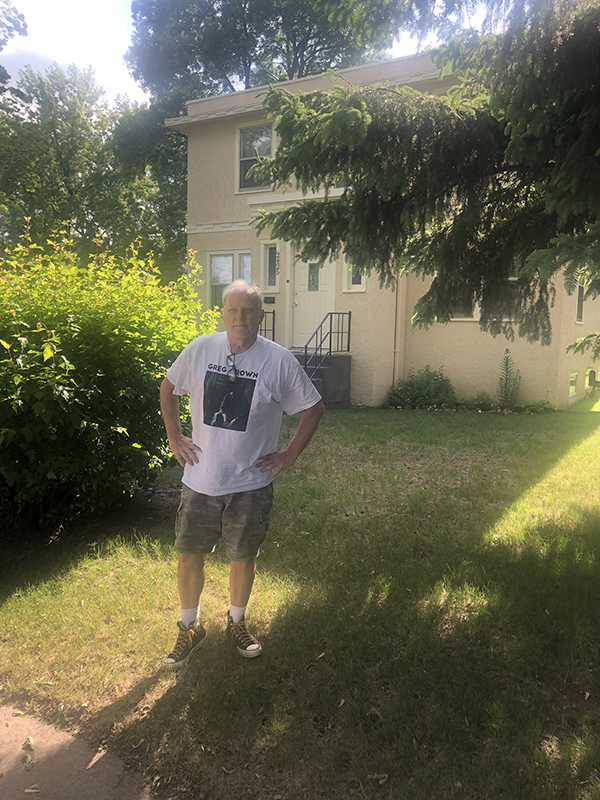
I’m at Dylan’s childhood home. (Photo by Roy.)
Spending all of my life as a journalist, it was a thrill to visit a town unprepared and with little research outside of the Dylan books I had read.
I asked Roy for a restaurant recommendation. He said there was a good downtown restaurant where he just had supper, but he forgot the name. Folks in Hibbing don’t sweat the small stuff.
I quickly learned that young Dylan lived in a contained world. From his house he could walk to the Memorial Building Arena (built in 1934), 400 E. 23rd St. where he performed in the Little Theatre and the lobby, according to the Hibbing Library. In “Chronicles, Volume 1” Dylan wrote about how professional wrestler Gorgeous George winked at him while he was playing from a makeshift platform in the arena lobby.
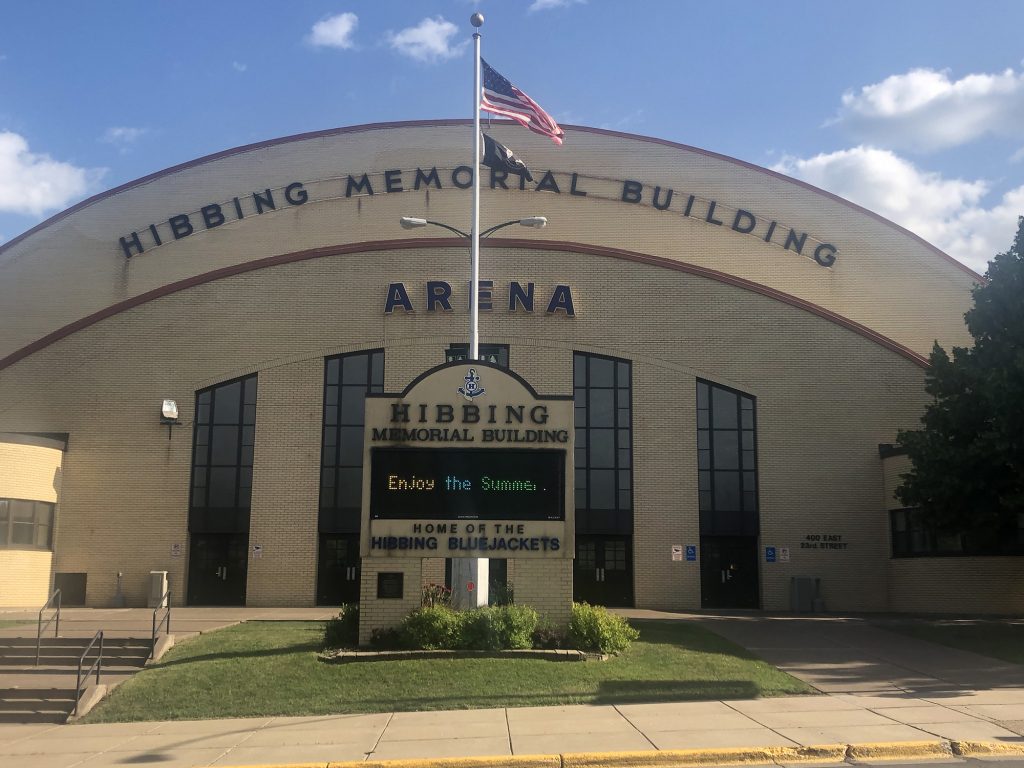
Memorial Building Arena where wrestler Gorgeous George winked at Bob.
Dylan could also walk to Hibbing High School, 800 E. 21st St., where his first performance was in 1959 on the high school stage. The class motto at the time was “I am a part of all that I have met.”
The high school is the site of the most public Dylan tribute in Hibbing. In October 2021, a group of volunteers installed a brick public art tribute in front of the high school to commemorate Dylan’s Nobel Prize in Literature which he was awarded in 2017. One side of the wall features the Nobel prize announcement while the other side contains a series of stainless steel panels that contain lyrics from more than 50 of Dylan’s songs. According to David Pichaske’s fine 2010 book “Song of the North Country: A Midwest Framework to the Songs of Bob Dylan” during his senior year of high school, Dylan led a petition drive to “impeach” an English teacher who had failed him.
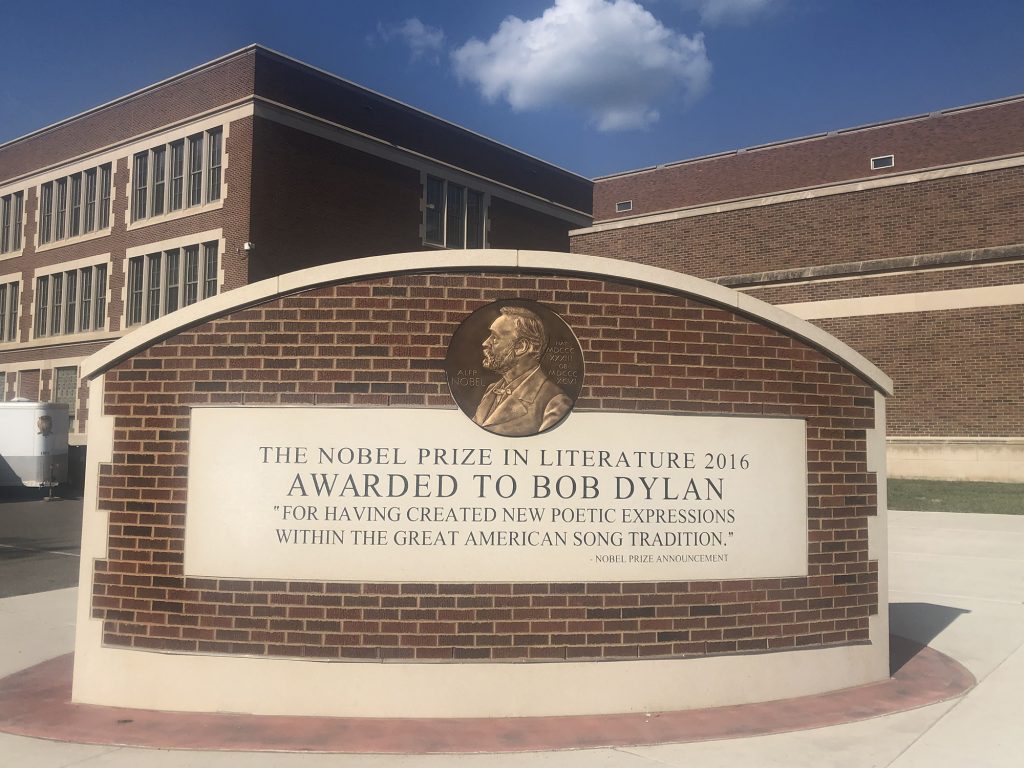
Dylan high school honor (D. Hoekstra photo)
Other Dylan buildings are concrete ghosts from the past. The Zimmerman furniture store, 1925 5th Ave. E. downtown is a clandestine Excel Business Systems store. Next door is the tiny Hibbing Bowling Center where Bob Zimmerman was a member of a team called the Gutter Boys that won the 1955-56 teenage bowling competition. Other formative sites like Crippa Music, 313 E. Howard is closed.
But all you need to absorb history is a big imagination.
I couldn’t think of another town where you can walk in so many formative footsteps of a contemporary music icon. Tulsa? I visited the magnificent Art Deco Will Rogers High School, in Tulsa where Leon Russell and David Gates of Bread went to school as well as Anita Bryant. Asbury Park? Macon, Ga.? Certainly, there are traces of budding music history in Harlem.
Wandering discovery is something Dylan has retained throughout his life. It has not been unusual for him to walk the streets of America in search of music history. I remember the late Knox Phillips telling me about Dylan showing up unannounced in a cab to visit his father, Sun Records founder Sam Phillips at their Memphis ranch house. And there’s the 2009 story about a New Jersey cop stopping Dylan as he was searching for Bruce Springsteen’s childhood home.
I discovered dinner at BoomTown Brewery. It is across the street from the four-story Androy Hotel, 502 E. Howard. Dylan’s Bar Mitzvah celebration was held at the Renaissance revival-style hotel. The hotel opened in June 1921 as the “Grand Hotel of Northern Minnesota.” Mining bigwigs held their events there and a faded sign on an exterior wall promotes supper club from long ago. The Androy had 142 rooms and is listed on the National Register of Historic Places. The Androy closed in November 1977. Today the upper level of the hotel is used for affordable housing under the auspices of building owner Trellis Co., a nonprofit Twin-Cities-based developer.
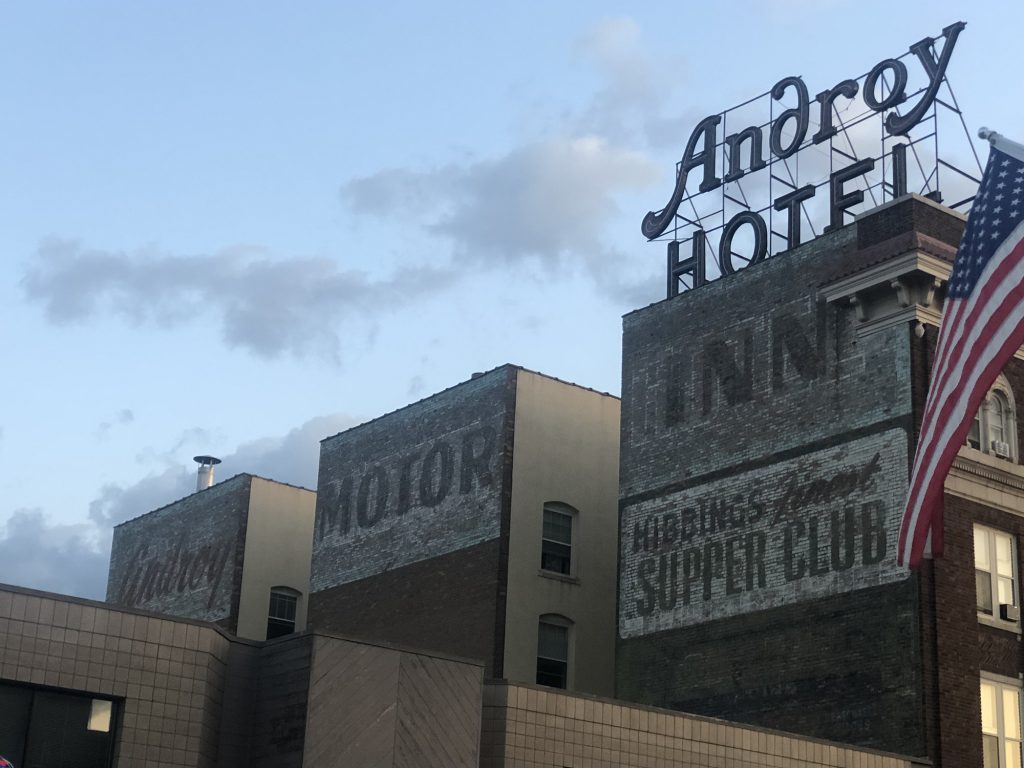
Supper Club history and Dylan history–what can go wrong?
In April, BoomTown owners Jessica and Erik Lietz announced a partnership with Trellis Co. to restore the 1920s ballroom of the hotel into an event space with a new commissary kitchen.
The brewery also has a unique history. Until 2014 it had been Zimmy’s, a Dylan-themed restaurant. And before that, it was a trolley car depot.
BoomTown still makes subtle nods to Hibbing’s favorite son, such as the “Tangled Up in Blueberry” wheat beer made with blueberry puree. BoomTown opened in Hibbing in 2017. Brewmaster Dennis Holland developed the award-winning Edmund Fitzgerald Porter for Great Lakes Brewing Co. in Cleveland.
The linchpin of my visit was the Hibbing Public Library. The librarians researched and assembled the Dylan walk, the nice young clerks at the front desk gave me some Dylan gossip, and by all means, do not miss the “Bob Dylan Exhibit” in the library basement.
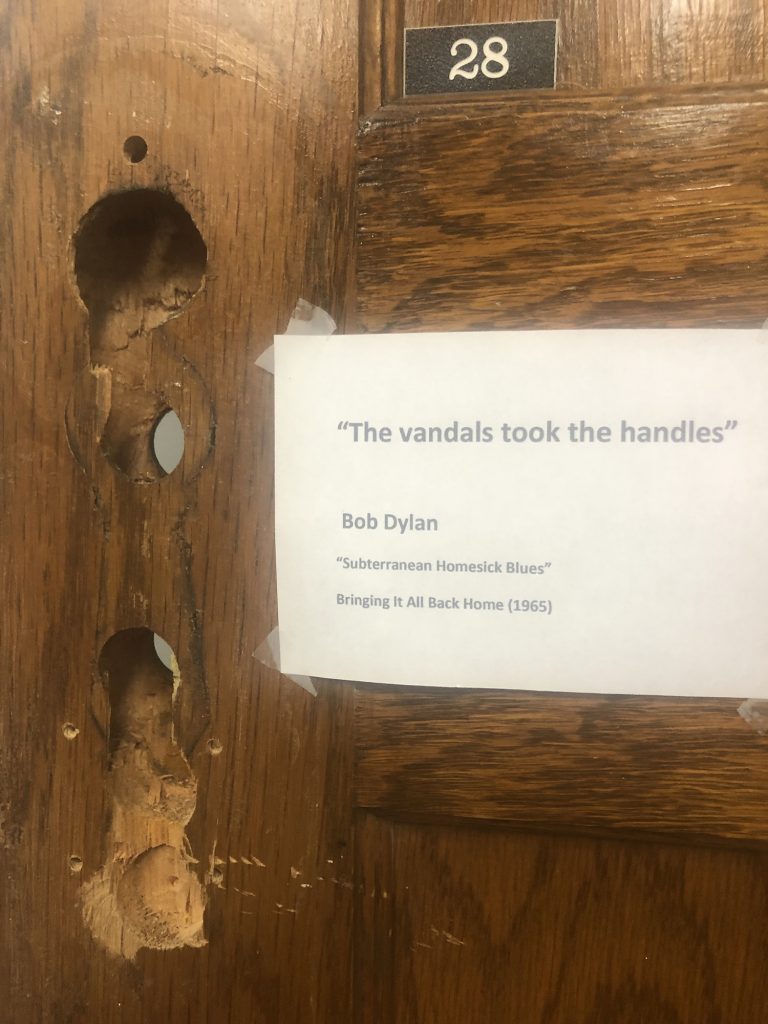
Door hardware from the Zimmerman home in the library Dylan Exhibit.
The room is filled with great and unusual Dylan archives such as original bathroom floor tile from the Zimmerman home and a Sears Roebuck and Co. guitar donated by Larry Fabbro, who was a bandmate in Dylan’s high school band the Cashmeres.
Banging away at the piano in Little Richard style , Dylan led the Cashmeres through “Jenny, Jenny Jenny” and “True Fire Mama” on April 5, 1957, at Hibbing High School. The centerpiece of the exhibit may be the lovingly odd pinata-influenced life-sized paper mache sculpture of Dylan done in 2007 by Hibbing artist Ann Schnortz.
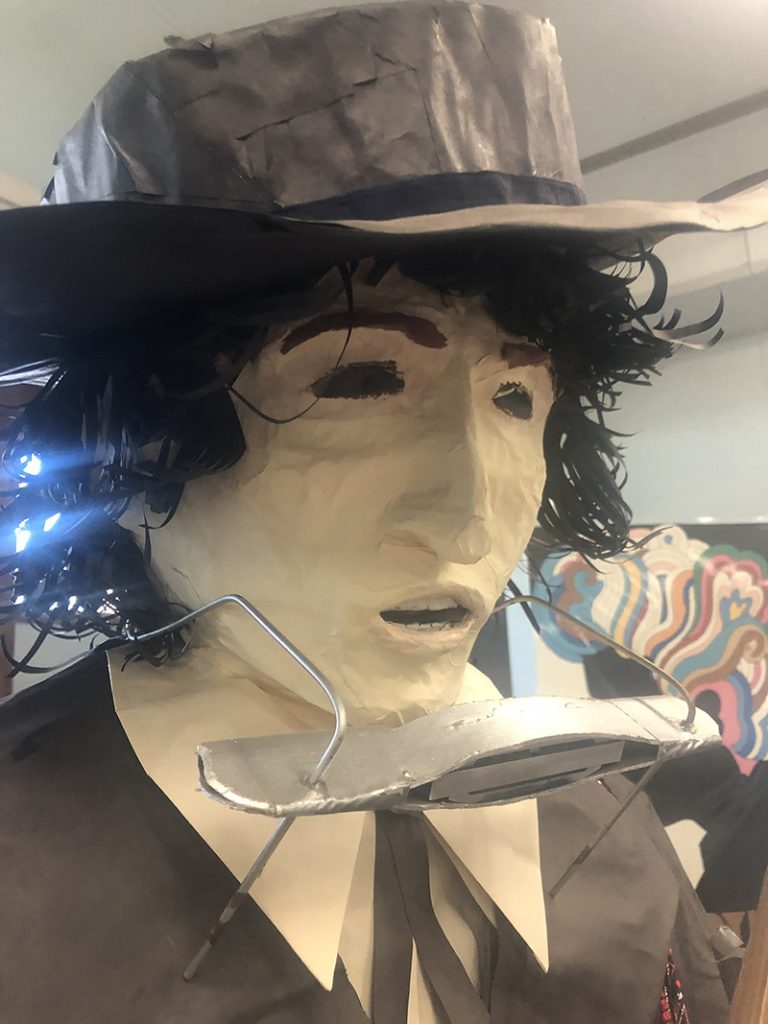
Paper Mache Bob (D. Hoekstra photo)
Visiting the “Bob Dylan Exhibit” is not like visiting the Bob Dylan Center in Tulsa. The exhibit’s basement door was closed when I arrived on an early Monday afternoon. The women at the front desk went on the public address system and announced that someone go downstairs and open the door for me . There is no admission charge and I had the room to myself. These are the kind of organic Dylan experiences in Hibbing that made my trip so memorable.
I couldn’t find a bookstore in Hibbing, but in Duluth I picked up a photo book on Hibbing history. Around 1920 to expand operations, the Oliver Iron Mining Company moved Hibbing to its present location, a mile south. The mining company built the Androy Hotel and moved the Lybba Theater, named after Dylan’s great-grandmother Lybba Edelstein.
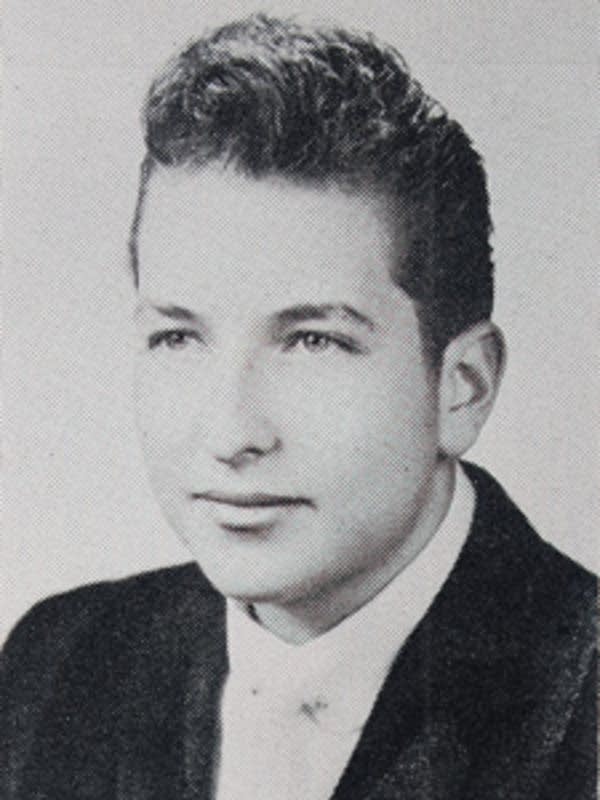
Senior High School Bob.
According to Hibbing Historical Society curator Erica Zubich, Lybba was married to Hibbing’s pioneer showman B.H. Edelstein. This begins to explain Dylan’s playful theatrical roots: Lybba’s daughter was Florence Edelstein Stone; Florence’s daughter was Beatty Stone Zimmerman, and Beatty’s oldest son is of course, Robert Allen Zimmerman. In the late 1940s, the magical theater was owned by Dylan’s uncles Max, Julius, and Sam Edelstein.
The Lybba building remains. Although it is not on the Dylan walk, the building is the site of the successful Sunrise Lybba Deli, and apartments, 2135 1st Ave.
I had to dig even deeper into iron mine country. I remember my Chicago area friend Laura Baratto telling me her mother had been mayor of Hibbing. When I returned from my trip Laura put me in touch with her mom, Pru Lolich.
After serving a four-year term on the city council, Lolich was elected mayor of Hibbing in 1998 and served throughout 2002. She lost her re-election bid to the late Rick Wolff. In 2006 Wolff was re-elected against Jason “The Mechanic” Roebuck who was believed to be the only candidate to ever rap his opening statement at a public forum, according to northern Minnesota blogger Aaron J. Brown.
As mayor, Lolich helped establish the “Dylan Days” music, literature , and arts festival that used to take place annually on Dylan’s May 24 birthdate. Dylan Days was discontinued in 2014.
“The decision-makers in Hibbing don’t know much about tourism,” Lolich said in an engaging mid-June phone conversation. “For example, you saw the Dylan exhibit in the library. But the library is not open on Saturday and Sunday and that’s when a lot of our tourists come in. Zimmy’s closed. And they had photographs and memorabilia and a lot of it was privately owned. It was great. When Zimmy’s went, that all went. We started Dylan Days when I was mayor. I thought it was very successful, people came from all over and overseas. We had hotels for them to stay in, too. You can’t have big events without places for people to stay.”
Today, there’s only one real hotel in Hibbing, a very nice Hampton Inn on the outskirts of town.
“A lot of people worked on Dylan Days,” said Lolich, who is a member of the Hibbing Historical Society. “All of a sudden we had trouble with funding. And there is a bit of a rivalry between Hibbing and Duluth.” When Dylan Days folded, locals suggested fans check out the Duluth Dylan Fest. But in recent years, Hibbing has stepped up its game with the Nobel Prize honor at the high school and the 2005 naming of 7th Avenue East as Bob Dylan Drive. The street signs were Hibbing’s first public recognition of Dylan.
There is no truth to the stories that Dylan has turned his back on Hibbing. Several residents were forthcoming on their Dylan spotting’s, mostly telling me he sneaks into Hibbing for funerals and people leave him alone.
“He’d come into town and drive an old camper so nobody would recognize him,” Lolich said. “He used to come back and visit some of the guys that played in his band. About four or five years ago I went to a funeral for my neighbor’s mother. I think her sister is married to David, Bob’s brother. The funeral started and all of a sudden this man and woman come in. They sit a couple of rows down from me and I’m thinking the man looks familiar. The funeral service went on and they got to the point where you turn around and shake hands. And yes, It was Bob Dylan. I thought maybe he would be at my neighbor’s house (for the reception), but no, he just snuck back out of town.”
Dylan is just one of several notable people to emerge from Hibbing. Basketball Hall of Famer and Grateful Dead fan Kevin McHale was born in Hibbing as was the late “Helter Skelter” District Attorney and author Vincent Bugliosi. In January 2000 Mayor Lolich gave McHale a key to the city in a public ceremony that included some of his Boston Celtic teammates like the late K.C. Jones. “There’s a group of people here who are really into Bob Dylan, like the people who renamed the street signs,” Ulrich said. “And there’s a certain age group that still does not appreciate Bob Dylan music, poetry, or anything.”
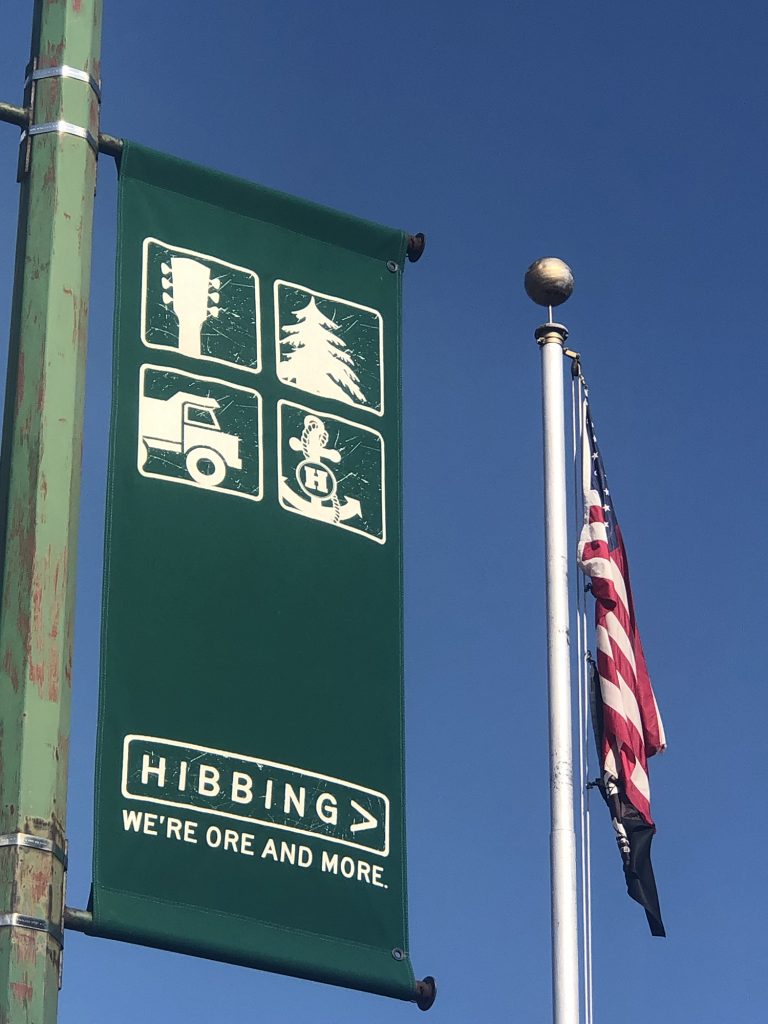
Hibbing in America.
Lolich is from Detroit Lakes, Mn. in Native American country about 160 miles west of Hibbing.
Her husband Anthony Baratto died from heart disease in 1975. He was only 39 years old. Lolich remarried and came to Hibbing with her six children in 1977. Her new husband Milan Lolich was from Hibbing and worked in the labs and later in management for Eveleth Mines (now Eveleth Taconite). He passed away from heart disease in 1995.
I wondered how Hibbing had changed since her arrival. Hibbing is in the heart of the Iron Range which consists of 175 miles of iron ore mining districts. “There were mine strikes and many closed,” Lolich explained. “Now there are three or four mines in the Iron Range.
“We can be viewed as a one-industry town with mining. We seemed to be rolling our way to bringing in more business and all of a sudden it stopped. We were waiting for a big mining project in the Nashwauk area, a few miles west of Hibbing. It’s been more than 20 years and it still hasn’t started. At one time logging was great. The Grand Rapids (Judy Garland’s hometown) area is good because of its location on Highway 169 and tourism is great in Virginia (pop. 8,400) because of its location on 73 and going up to the Boundry Waters. Hibbing is in the middle.”
According to the Hibbing Historical Society, between 1892 and the 1920s there were more than 175 mining locations in the Mesabi Range of Hibbing where there are large deposits of iron ore. Virginia is now considered to be the Mesabi Range’s commercial center. Sometimes old dreams are like a melting icicles.
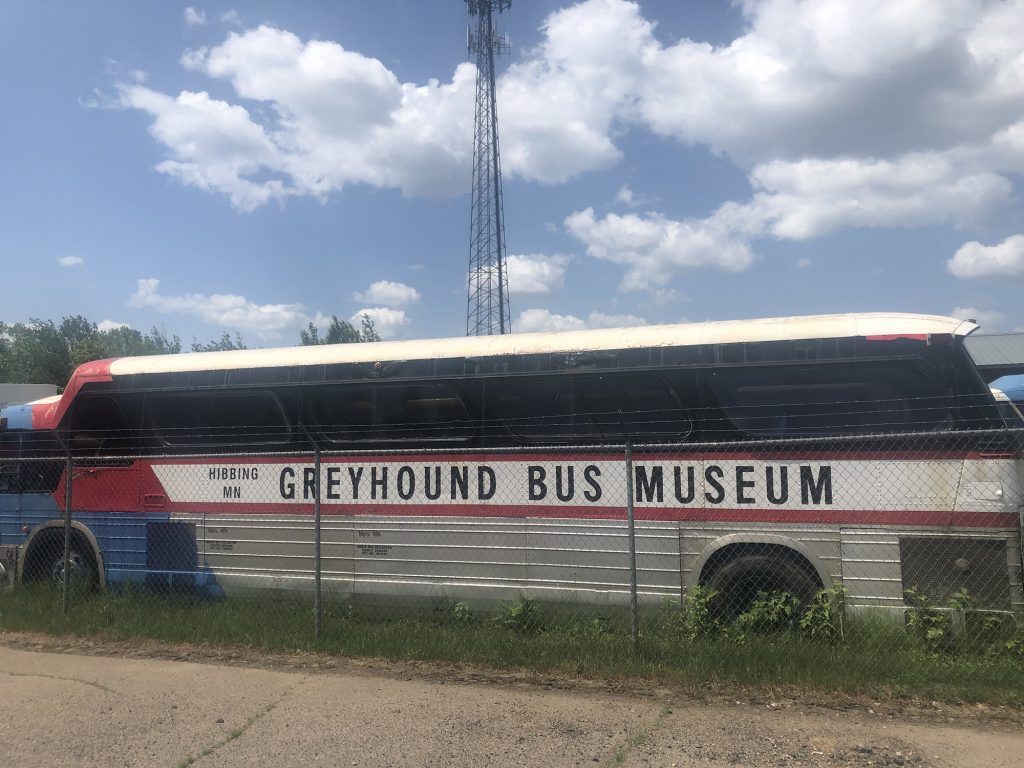
Going places in Hibbing.
The bonus aspect of my visit was what locals call the “Bus Origin Museum.” It is actually the Greyhound Bus Museum and is considered the birthplace of the Greyhound bus line. The company was born in 1914 when a Hupmobile was used to transport iron ore miners across the Iron Range. Built to resemble a bus station, The Greyhound museum opened in 1999 and includes several vintage buses, driver’s uniforms, and more. I spent nearly 90 minutes in the museum.
Pat, the fun retired volunteer docent answered all of my questions and told me that one website voted the Greyhound Museum for “Best Bathroom Art in a Museum.” Here is a photo of when I snuck into the woman’s bathroom. Just like the Bob Dylan Exhibit at the library, I was the only visitor at the Greyhound Museum.
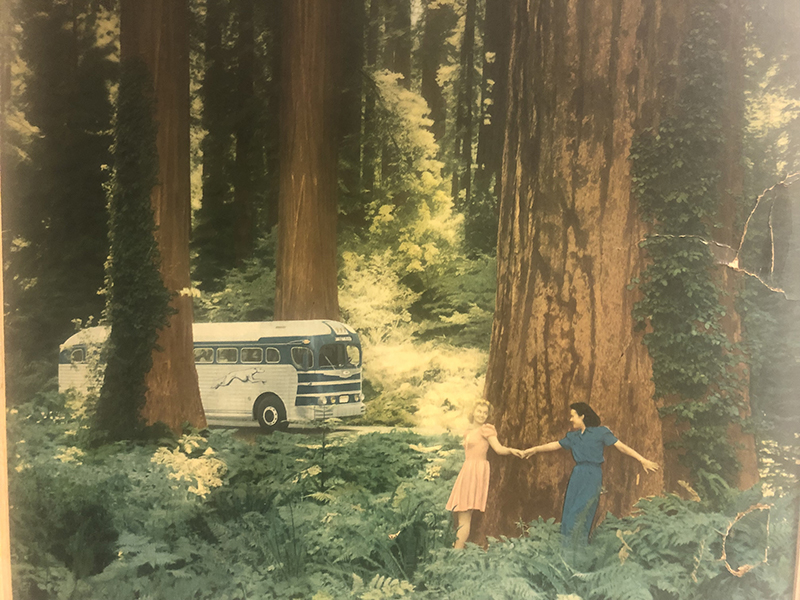
Excellent bathroom art at bus museum. (D. Hoekstra photo)
Greyhound was a gentle reminder of how the bus line once reached out to all the humble nooks and crannies of America. For example, I noticed a 1930 sign for the Northland Greyhound Lines that made a stop at the Viroqua, Wi. station. And then I thought about the time I interviewed Dylan for a 2000 PBS documentary we did on Chicago’s Staple Singers. Dylan told us that while in Iron Range country he could hear the tremolo guitar of Pops Staples rolling over the radio from distant and mysterious places.
The open lands of Hibbing made these places possible and real for anyone with untethered dreams in the early 1950s. You could count all the stars in the sky. Dylan would not be who he is without his early days in Hibbing. That is why this town is a must-see for fans of American music.
So Dylan should have the final world, in an excerpt I saw at the Hibbing library from a 1972 interview he did with Playboy magazine: “….I’m North Dakota-Minnesota-Midwestern. I’m that color. I speak that way. I’m from someplace called the Iron Range. My brains and feelings have come from there. I wouldn’t amputate on a drowning man, nobody from out there would.”
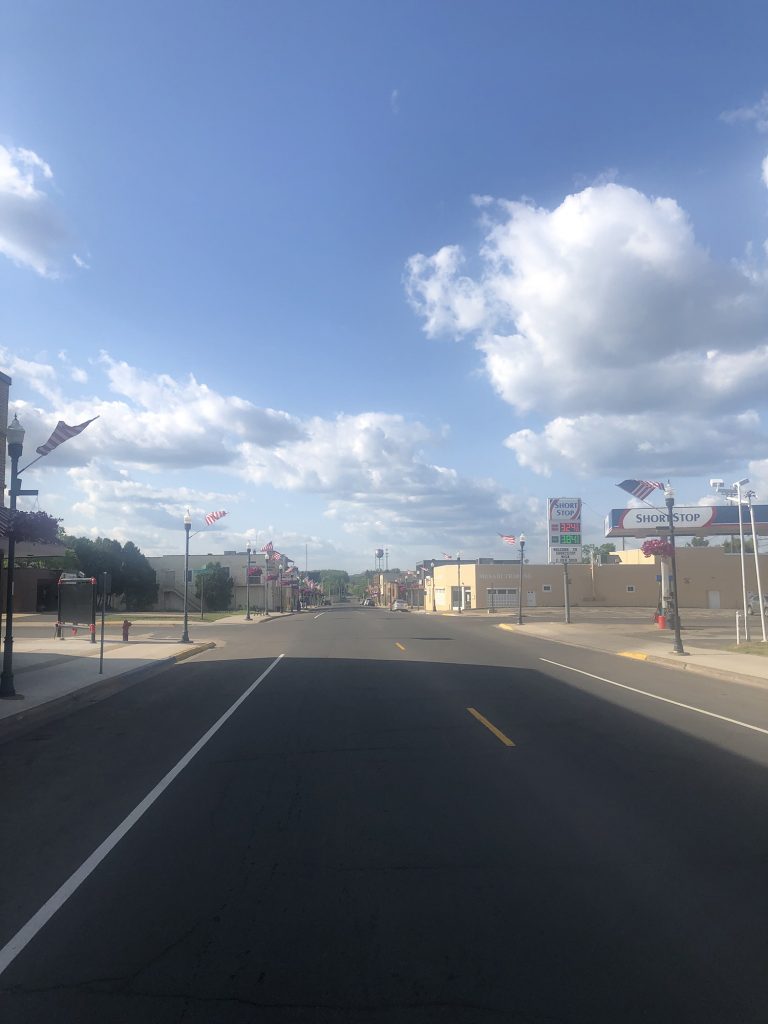
Hibbing; June 11, 2023 (D. Hoekstra photo)

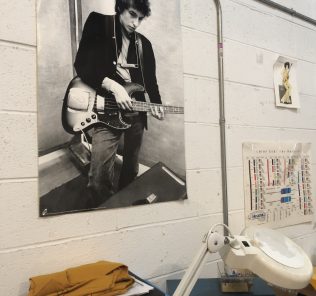


Great article on Bob’s Hibbing days…. recently I found a site you were probably not aware of…I posted my find on Facebook Group: Abandoned Minnesota…it has nearly 1000 views and countless comments.
https://www.facebook.com/share/p/QStgPCKJVFT36w6M/?mibextid=xfxF2i
Thank you, Marvin!